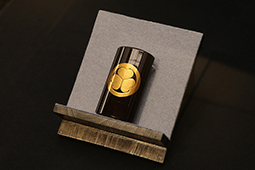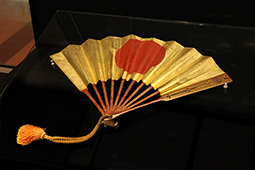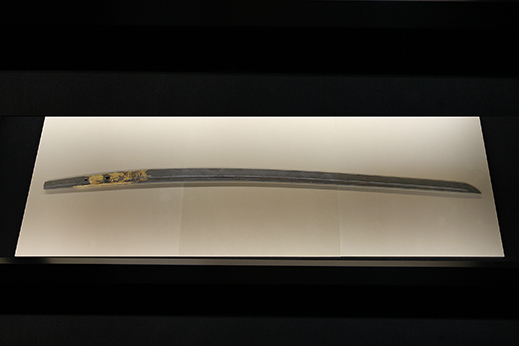 |
Focus features two in-depth reviews each month of fine art, architecture and design exhibitions and events at art museums, galleries and alternative spaces around Japan. The contributors are non-Japanese art critics living in Japan. |
|
|
 |
 |
 |
Art on the Fly: The Discovery Museum at Haneda Airport
Alice Gordenker |
 |
Kabuto (helmet) made in 1531 for Tokugawa Ieyasu by master ironwork craftsman Myochin Nobuie. |
Most people want to get through airports as quickly as humanly possible, even as earlier check-in requirements and longer security lines mean we're spending more time in terminals than ever before. But at Tokyo's Haneda Airport, there is good reason to linger: a small but impressive museum -- with no admission charge -- that exhibits Japanese art of exceptional quality.
The Discovery Museum is located on the third floor of Terminal 2 at Tokyo's Haneda Airport. Subdued lighting and comfy sofas encourage visitors to relax. |
The Discovery Museum, now celebrating its fifth anniversary, is the first and only museum located within an airport in Japan. Although many air terminals around the world now display modern sculpture or local crafts to brighten the corridors that funnel passengers to planes, it's rare to find dedicated museum space. Amsterdam's Schiphol Airport was the first to launch fully into art, opening a satellite of the city's famous Rijksmuseum in 2002 to showcase masterpieces of Dutch painting, including works by Rembrandt and Vermeer. Haneda Airport followed in 2010, opening the Discovery Museum with the twin goals of expanding the airport's amenities while making Japanese art and culture more accessible.
"In bringing high-quality art to the airport, we are trying to draw in people who may not normally be museum-goers, and give them an opportunity to experience art and culture in a comfortable setting," explained Discovery Museum curator Madoka Sawada. "The fact that the museum is free encourages people to stop in with their children, for example, and we hope such early exposure will spark a desire to learn more, and perhaps even a life-long interest in art." With an estimated 70 million passengers passing through the airport every year, the museum has significant potential reach; its location on the third floor of a domestic terminal, however, puts it a bit out of the way for international travelers.
Nearly all of the museum's exhibitions to date have been assembled from the collection of the Eisei-Bunko Museum in Tokyo's Bunkyo ward, which preserves historical artifacts and artworks passed down through the Hosokawa samurai clan. (The normally staid institution, presided over by a former prime minister, has been much in the news lately for hosting what's billed as the first-ever domestic exhibition of shunga, traditional Japanese erotic paintings and prints.) Past offerings at the Discovery Museum have included shows of Zen ink paintings and celebrated tea-ceremony utensils, all from the Eisei-Bunko collection.
 |
|
 |
|
|
|
Left: Inro medicine case owned by Tokugawa Mitsukuni (1628-1700), second daimyo of the Mito domain; black lacquer embellished in gold maki-e with the Tokugawa hollyhock crest, Momoyama period (16th c.). Right: Folding military fan used by Tokugawa Ieyasu at the Battle of Sekigahara (1600); vermilion lacquer and paper covered with gold leaf, early Edo period (17th c.) (on exhibit through Nov. 10). |
The current exhibition, whose Japanese title translates as "Tokugawa Ieyasu: Realm at Great Peace," is a departure. To commemorate the 400th anniversary of the death of Tokugawa Ieyasu, the museum has collaborated for the first time with the Tokugawa Museum in Mito, Ibaragi Prefecture, to bring noted treasures of the Tokugawa family collection to Tokyo. Ieyasu (1543-1616) was the founder and first shogun of the Tokugawa shogunate, which ruled Japan from the Battle of Sekigahara in 1600 until the Meiji Restoration in 1868. A strong military leader, Ieyasu brought an end to more than a hundred years of war and ushered in an extended period of calm referred to as the "realm at great peace" (tenka taihei). He also moved the center of government to Edo, where Tokyo now stands, effectively positioning Tokyo to become what it is today, the hub of Japan's politics, commerce and culture.
A legendary Go game board known as "Mai Budo," Momoyama period (16th c.). |
The museum is not large and there are only about ten exhibits on display at any one time, but nearly every one is a standout in terms of both beauty and historical significance. There is, for example, an impressive footed board for the game of Go that dates back to the Momoyama period (1573–1615). Crafted from a single piece of wood, it is known as the "Mai Budo" ("dancing grapes") board because of the unusual circular patterns in the natural grain. The exhibit is all the more arresting when one learns that this very board was used in a historic match between Ieyasu and Toyotomi Hideyoshi (1537-1598), a preeminent warrior and statesman and another great figure of that time. The board is nicely displayed with two lacquer-and-gold goke, the containers used to hold the black and white game pieces.
In most museums, Japanese military helmets are shown atop full sets of armor, where they are positioned too high for a close look. Here, however, a kabuto helmet, worn by Ieyasu himself, is exhibited solo and at eye level, tipped slightly forward so you can see even fine detail. One surprise is the tiny heart patterns worked into the metal filigree.
 |
|
A katana sword once owned by Date Masamune and known as "Shokudaigiri Mitsutada," mid-Kamakura period (13th c.). |
The biggest draw, however, is clearly a sword known as "Shokudaigiri Mitsutada." Made in the 13th century by Mitsutada, a legendary Bizen swordmaker, and once owned by famed warrior Date Masamune (1567-1636), it later passed into the Tokugawa family. Its name, which means "Mitsutada's sword that cut a candle stand," is said to come from an event in which Masamune punished a disloyal vassal by beheading him. The sword not only took off the servant's head, but also cut through a heavy metal candle stand that stood nearby.
The sword was long rumored to have been lost in a fire at the time of the 1923 Great Kanto Earthquake. It did, in fact, survive, but was badly damaged: the hilt burned and a gold fitting melted and fused onto the blade. Ever since, the fabled sword has remained out of sight in a Tokugawa family storehouse. But last year, when the Tokugawa Museum announced it would put the sword on display in Mito for a limited time, the phone line was swamped with inquiries. So many people turned up to see the sword that its run was extended for an additional three weeks.
While "Shokudaigiri Mitsutada" has been famous for centuries, and is described in many historical texts, its current popularity is explained largely by the fact that a popular online game has a character by the same name. In "Touken Ranbu," players assume the roles of sages who have the power to travel to the past and breathe life into inanimate objects, including historical swords. The swords take the form of handsome young men, and join players in trying to defeat evil forces.
Gallery talks at the Discovery Museum, offered twice on Wednesdays, typically attract 10 to 20 visitors, according to museum staff -- yet there were close to 50 participants on the day I attended. Many were "Touken Ranbu" fans who said they came to the airport specifically to see the "Shokudaigiri Mitsutada" sword, yet stayed to hear the talk and view the rest of the exhibits. In that sense, the Discovery Museum has touched down smoothly in its quest to help others discover Japanese art.
All artworks shown are from the collection of the Tokugawa Museum.
|
 |
| | Tokugawa Ieyasu: Tenka Teihei no Kiseki (Tokugawa Ieyasu: Realm at Great Peace) |
| | Discovery Museum (in Japanese only) |
| | 10 October - 13 December 2015 (closed 11 November for a change of exhibits) |
|
 |
 |
Alice Gordenker
Alice Gordenker is a writer and translator based in Tokyo, where she has lived for more than 16 years. In addition to writing about the Japanese art scene she pens the "So, What the Heck Is That?" column for The Japan Times, which provides in-depth reports on everything from industrial safety to traditional talismans. She also writes about early Japanese photography. |
|
 |
|